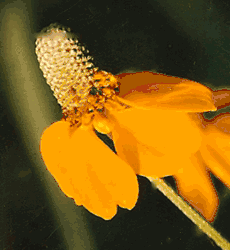 Rudbeckia hirta An important native prairie plant used by Native Americans and early settlers medicinally and as an important component in dye making. Black Eyed Susanís sunny yellow flowers brighten the late summer garden and feed both butterflies and bees. The seed heads then should be left on the plants as an important food source for wild birds. 2-3 feet. Full sun. Seeds should be planted in cold conditions. Perennial. 100+ seeds. |
 Echinacea purpurea Purple Coneflower is a native US prairie plant that was brought into gardens during the 1700s. Prized for its many medicinal properties, the large purple blooms will be covered with butterflies and bees in late summer. The seed heads feed many types of wild birds. The flowers are absolutely regal in the garden bed, held on strong stems. Very pretty! 3 feet. Full sun. Seeds should be planted in cold conditions. Perennial. 50+ seeds. |
 Echinacea pallida Pale Coneflower is a native US prairie plant that has pale lavender petals held less upright than those of the classic Purple Coneflower. Loved by butterflies and bees when flowering and then used by birds for seeds. Plants overall have a more narrow and graceful habit than the Purple Coneflower and tend to bloom a few weeks earlier. Not commonly seen. Most/full sun. Seeds should be planted in cold conditions. Perennial. 3 feet. 50+ seeds |
 Echinacea tennesseensis A native US plant that has pretty pink petals that curve slightly upwards, this rare coneflower was one of the first plants to be placed on the Endangered Species list in 1979 after its discovery in a small area in Tennessee (it was thought before this to be extinct). It was removed from the list in 2011 after a recovery due to extraordinary conservation efforts. Most/full sun. Seeds should be planted in cold conditions.
Perennial. 3 feet. 50+ seeds |
 (Ratibida columnifera) Also known as Upright Prairie Coneflower, Mexican Hat is a native wildflower found from Mexico across the United States and into southern Canada. Flowers are produced from mid-summer on and will attract and feed bees and butterflies. Seeds are eaten by many types of seed eating birds in autumn. Tolerates poor conditions well. Seeds should be planted in warm conditions. Perennial. Most/full sun. 1-3 feet. 50+ seeds |
 Ratibida pinnata This pretty native is less commonly seen in the naturalized garden but provides a striking habit - the plants are delicate and tall and move with any touch of a breeze. The flowers are long lasting and heavily produced through late summer. The flowers feed butterflies and bees, the foliage is important for many caterpillar species, and the seed heads feed finches. 2-3 feet. Full sun. Seeds should be planted in cold conditions.
Perennial. 100+ seeds. |